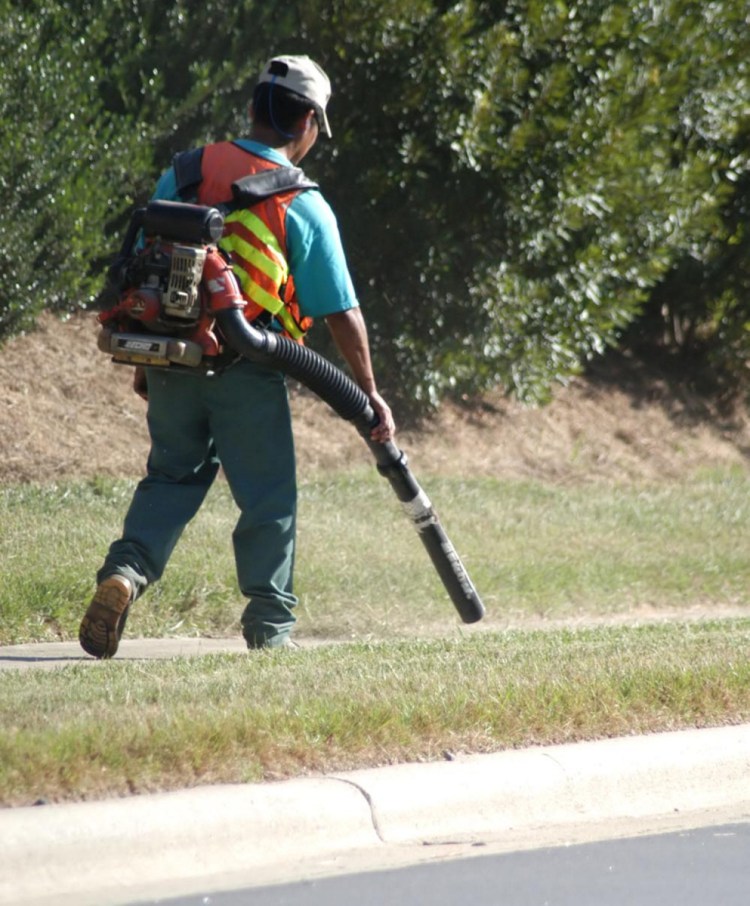It’s a gorgeous summer morning, fragrant with the scents of lilac and abelia, but my office windows are shut. A swarm of leaf blowers has descended just down the road, generating plumes of dust and a persistent snoring roar.
There is little to redeem these wasteful and irritating yard wands now used liberally by homeowners and lawn care crews, not just in fall but year-round. A manufacturer suggests using its “leaf” blower to break up matted grass, clean parking lots, scour rain gutters, move light snow and – most incredibly – to “dry off pavement.”
Okay, let’s have a show of hands from those who untangle their hair, clean tile grout and dry the bathroom floor with their hair dryer. No one? Really? But we could be generating noise and burning electricity to do these tasks more “efficiently” with a forceful stream of air, no?
Many technological advances indisputably enhance our collective quality of life. But why do some inventions that so obviously fail to promote the public good still endure?
Most leaf blowers use a mix of oil and gas that generates – from their relatively small motors – vastly disproportionate volumes of carbon monoxide (CO), nitrous oxides (fueling acid rain), and hydrocarbons (a source of unhealthy ground-level ozone). It’s easy to place blame for high-ozone days on tourists and traffic back-ups, but what if we’re generating more smog in our own backyards?
A 2011 test done by Edmunds revealed that a consumer-grade two-stroke leaf blower generated nearly 300 times more hydrocarbons than a 6,200-pound Ford F-150 pickup truck. To equal the hydrocarbon emissions from half an hour of yard work with that blower, Edmunds concluded, you could drive that pickup 3,887 miles – say from Portland, Maine, to Juneau, Alaska.
Then there’s the issue of what air policy specialists politely term “fugitive dust emissions.” A leaf blower can kick up no less than 5 pounds of fine particulates each hour. What is in those clouds wafting up and settling on the operator and nearby people and wildlife? It could be some mix of mold spores, pesticides, pollen, insect parts (browntail moth hairs, anyone?), dried animal feces, fungi and heavy metals. Perhaps we should leave it there (if only those operating leaf blowers would do the same!).
Leaf blowers assault the ears as well as the lungs. A 2017 Centers for Disease Control publication cites leaf blowers as a potential culprit in hearing loss, noting that two hours operating a 90-decibel leaf blower without protective wear can cause permanent damage.
It’s not just the decibels that are a problem, though; it’s what one aural analysis of leaf blowers calls their “spectral character” (having frequencies that fall in the “middle of the sensitive range of human hearing”). That’s why they tend to irritate listeners even more than snowblowers or lawn mowers.
Maddening noise from gas-powered blowers has prompted some municipalities to adopt ordinances restricting their use or outright banning them. Maybe that’s the only way to change course, but I’d like to think that homeowners – and even yard care professionals – might start setting their own limits.
Evan Frace, owner of Greener Grounds Landscaping in Owls Head, affirms that change is happening – in part because some workers prefer not to use leaf blowers. Frace uses relatively quiet electric mowers and fires up blowers only briefly to get clippings off walkways and driveways.
For leaves, Frace says, “hand tools are by far superior, way more efficient.” When using rakes, he adds, “you can pick and choose more” what you’ll target, making the process “just as fast, if not faster.” He finds the blowers “non-discriminate,” kicking up far too much debris and creating a hazard. With raking, he adds, his crew does not need to wear masks.
Frace understands that blowers can save labor costs on expansive properties, but he finds at smaller residential settings, there’s “not huge savings” in going the gas-powered route, particularly when factoring in equipment maintenance.
Given only minimal time savings to using blowers and significant environmental and public health costs, why are they still so ubiquitous at every season of the year? It can only be the illusion of efficiency, creating a dust cloud of activity that feels momentarily like productivity and progress.
But with blowers, we’re really just redistributing dirt. The sandblasted yards and parking lots don’t remain tidy for long. And peace and well-being are left in the dust.
Marina Schauffler provides research, writing, and editing services to nonprofit and social enterprise organizations through Natural Choices (naturalchoices.com).
Send questions/comments to the editors.



Comments are no longer available on this story